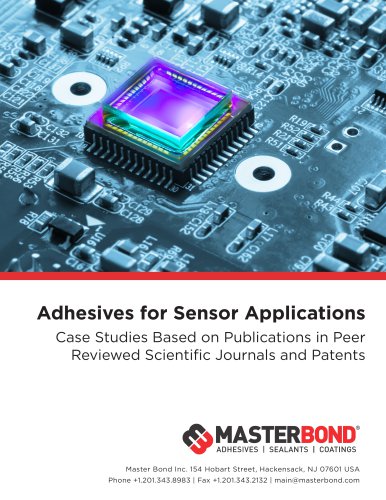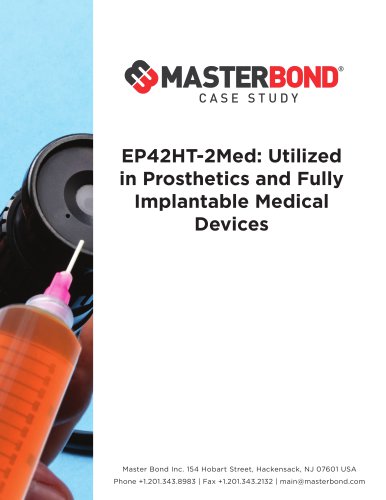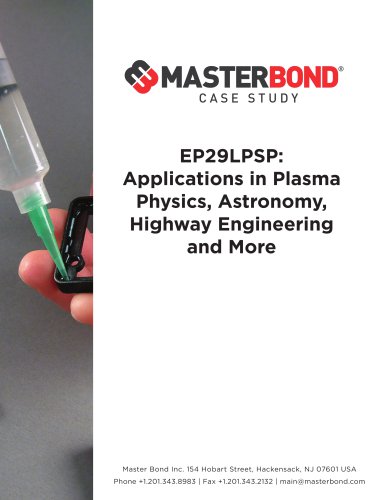 Website:
Master Bond
Website:
Master Bond
Catalog excerpts
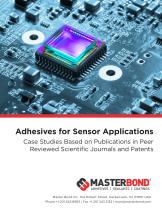
Adhesives for Sensor Applications Case Studies Based on Publications in Peer Reviewed Scientific Journals and Patents ADHESIVES I SEALANTS I COATINGS Master Bond Inc. 154 Hobart Street, Hackensack, NJ 07601 USA Phone +1.201.343.8983 | Fax +1.201.343.2132 | main@masterbond.com
Open the catalog to page 1
Table of Contents Introduction: Adhesives for Sensor Applications . . . . . . . . . . . . . . . . . . . . . . . . . . . . 3 EP30LTE-LO: Bonding MEMS temperature sensors . . . . . . . . . . . . . . . . . . . . . . . . . . . 4 EP37-3FLFAO: Bonding temperature sensors . . . . . . . . . . . . . . . . . . . . . . . . . . . . . . 5 EP21TDCN: Bonding dissimilar substrates in pyroelectric sensors . . . . . . . . . . . . . . . . . . . . 6 EP30HT: Coating interconnects . . . . . . . . . . . . . . . . . . . . . . . . . . . . . . . . . . . . . 7 EP30Med: Sensor encapsulant in prosthetic device . . . ....
Open the catalog to page 2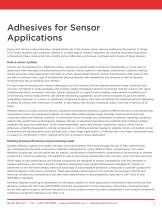
Adhesives for Sensor Applications Epoxy and silicone compounds play a fundamental role in the diverse sensor devices underlying the internet of things (IoT), smart products and advanced systems in a wide range of industry segments. By bonding and protecting sensor components, these compounds help simplify sensor fabrication and ensure continued performance of these devices. Role in sensor systems Sensors are the backbone of a digitized society, measuring a broad range of physical characteristics in every type of application from everyday consumer products to mission critical systems in...
Open the catalog to page 3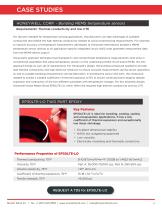
CASE STUDIES HONEYWELL CORP. - Bonding MEMS temperature sensors Requirements: Thermal conductivity and low CTE For devices intended for temperature sensing applications, manufacturers can take advantage of available compounds that exhibit the high thermal conductivity needed to avoid compromising measurements. For example, to improve accuracy of temperature measurement, developers at Honeywell International bonded a MEMS temperature sensor directly to an application-specific integrated circuit (ASIC) that generates measurement data from the MEMS device output.1 Honeywell's approach...
Open the catalog to page 4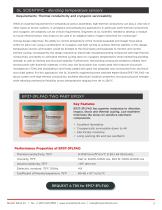
GL SCIENTIFIC - Bonding temperature sensors Requirements: Thermal conductivity and cryogenic serviceability While an essential requirement for temperature sensor assemblies, high thermal conductivity can play a vital role in other types of sensor systems. In aerospace and astrophysics applications in particular, both thermal conductivity and cryogenic serviceability can be critical requirements. Engineers at GL Scientific needed to develop a module to house infrared sensor chip arrays to be used in an adaptive optics imager instrument for a telescope.2 Among design objectives, the ability...
Open the catalog to page 5
Bonding dissimilar substrates in pyroelectric sensors In many applications, sensor fabrication often involves bonding of significantly different materials. For example, the availability of ferroelectric polymer (PVDF, which typically needs to be chemically etched for good adhesion) in thin foils, permits design of specialized pyroelectric sensors. Pyroelectric sensors are highly sensitive to radiated energy across a very broad spectrum ranging from ultraviolet through visible and infrared to millimeter wavelengths. By assembling PVDF foils with substrates in multilayered structures, sensor...
Open the catalog to page 6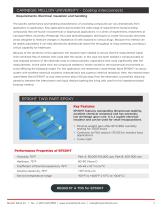
CARNEGIE MELLON UNIVERSITY - Coating interconnects Requirements: Electrical insulation and handling The specific performance and handling characteristics of a bonding compound can vary dramatically from application to application. Few applications demonstrate the wide range of requirements facing bonding compounds that are found in biochemical or biophysical applications. In a series of experiments, researchers at Carnegie Mellon University (Pittsburgh, PA) used photolithographic techniques to create microscopic electrode arrays designed to measure changes in impedance of cells exposed to...
Open the catalog to page 7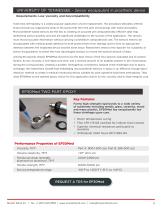
UNIVERSITY OF TENNESSEE - Sensor encapsulant in prosthetic device Requirements: Low viscosity and biocompatibility Total knee arthroplasty is a widely popular application of joint replacement. The procedure alleviates arthritic knee joint pain by capping the ends of the bones that form the joint and kneecap with metal and plastic. Microcantilever-based sensors are the key to creating an accurate yet computationally efficient data map. Optimizing sensor quantity and size are significant challenges to the success of the application. The sensors must record accurate information without...
Open the catalog to page 8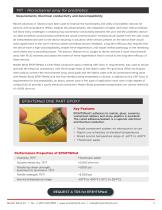
Requirements: Electrical conductivity and biocompatibility Recent advances in robotics have been used to improve the functionality and utility of prosthetic devices for persons with amputations (PWA). Despite the advancements, the integration of upper and lower limb prostheses still faces many challenges in enabling truly biomimetic functionality between the user and the prosthetic device.7 An ideal prosthesis would possess bidirectional neural communication-existing neural signals from the user could be interpretated and sent to the device resulting in actuation while sensors present on...
Open the catalog to page 9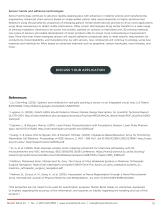
Sensor trends and adhesive technologies Sensor technology continues to advance rapidly, keeping pace with advances in material science and manufacturing engineering. Advanced strain sensors based on single-walled carbon tube nanocomposites or highly sensitive heat detectors using the pyroelectric properties of emerging gallium nitride (GaN) devices promise to drive novel applications using these nanosensors to detect subtle phenomena. Other sensor technologies bring similar benefits to a wide range of sensing modalities. Destined to be woven into textiles, painted on surfaces or fabricated...
Open the catalog to page 10All Master Bond catalogs and technical brochures
-
EP42HT-2Med
4 Pages

